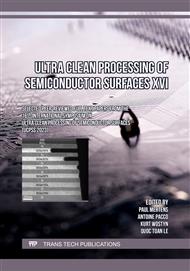p.263
p.268
p.275
p.280
p.289
p.296
p.302
p.311
p.318
Sulfuric Acid Reduction in Post-Ash Cleans
Abstract:
Photoresist after implantation is commonly removed either by wet chemical dissolution with sulfuric acid, or by dry ash stripping followed with a wet cleaning. To prevent any photoresist residues, sulfuric acid is still conserved in post ash cleans as additional safety. However, by ensuring sufficient over ash time, SPM (Sulfuric acid Peroxide hydrogen Mixture) chemical need becomes less essential. This paper reevaluates the benefit of SPM after dry ash stripping regarding the environmental context. The advantages of dry ash stripping with clean, compared to wet stripping are outlined. The study introduces prior analyses on defectivity and material consumption. Finally, device matching and yield stability, defined as the main success criteria, are described.
Info:
Periodical:
Pages:
289-295
Citation:
Online since:
August 2023
Keywords:
Price:
Сopyright:
© 2023 Trans Tech Publications Ltd. All Rights Reserved
Share:
Citation:


